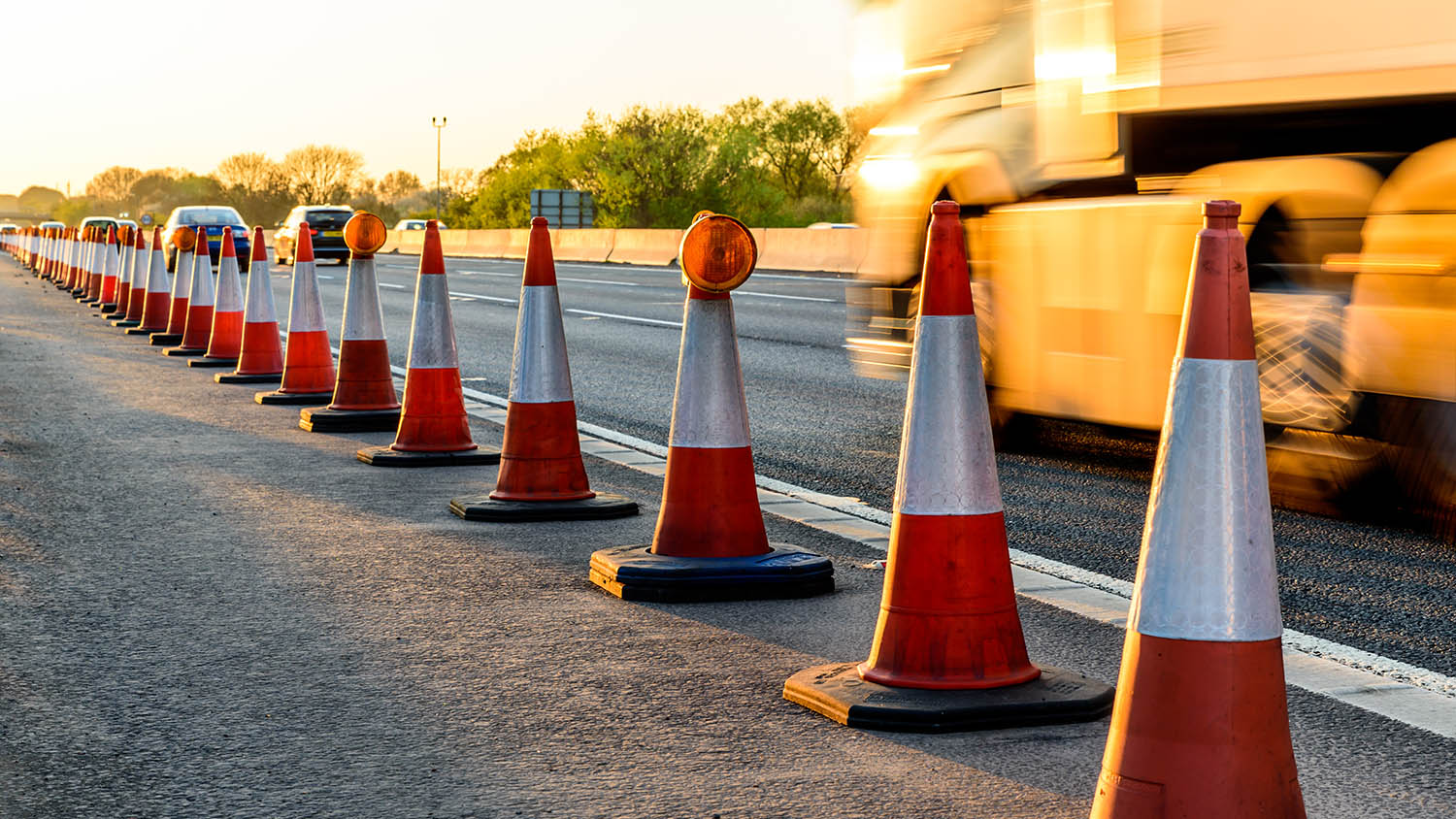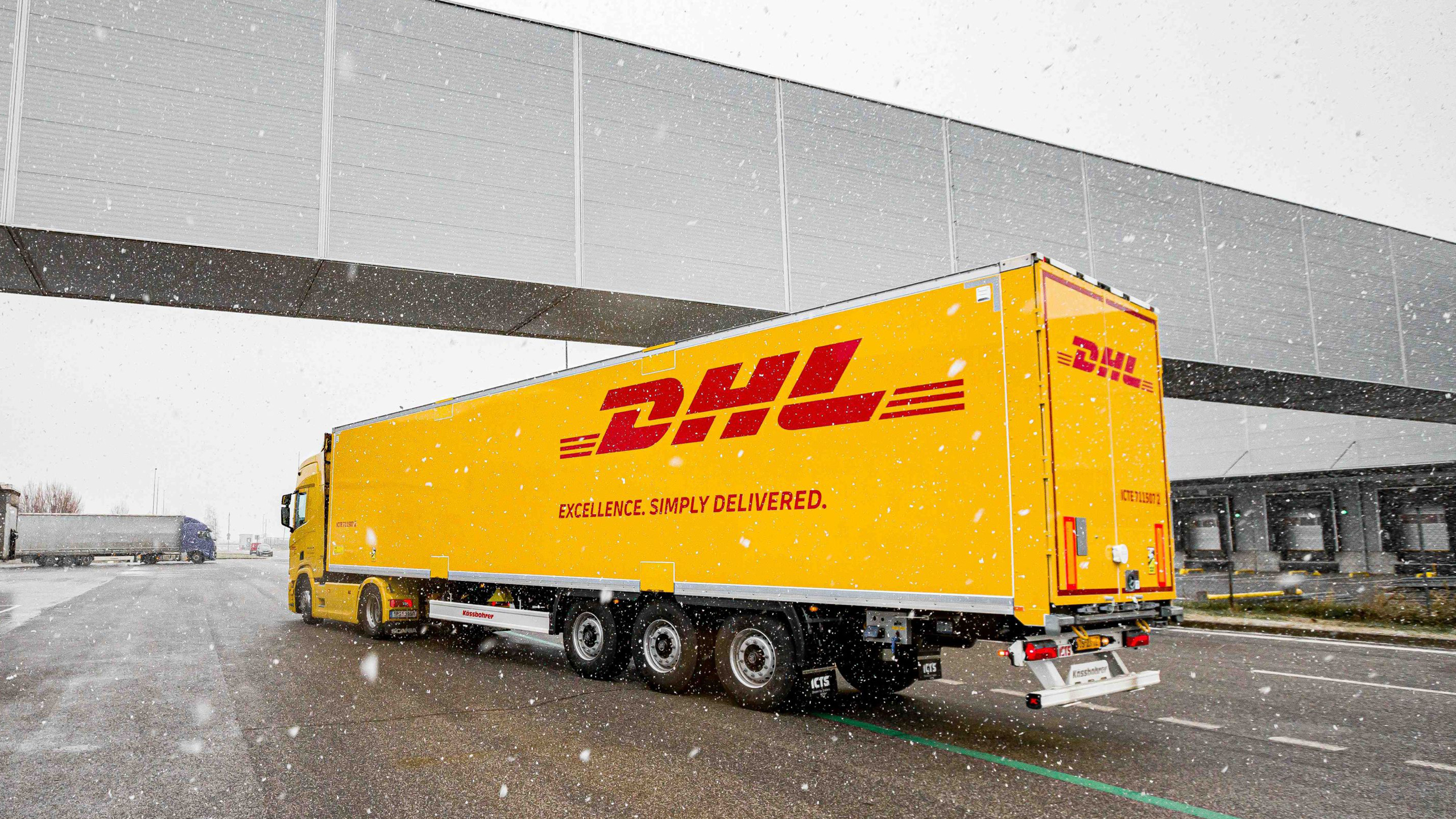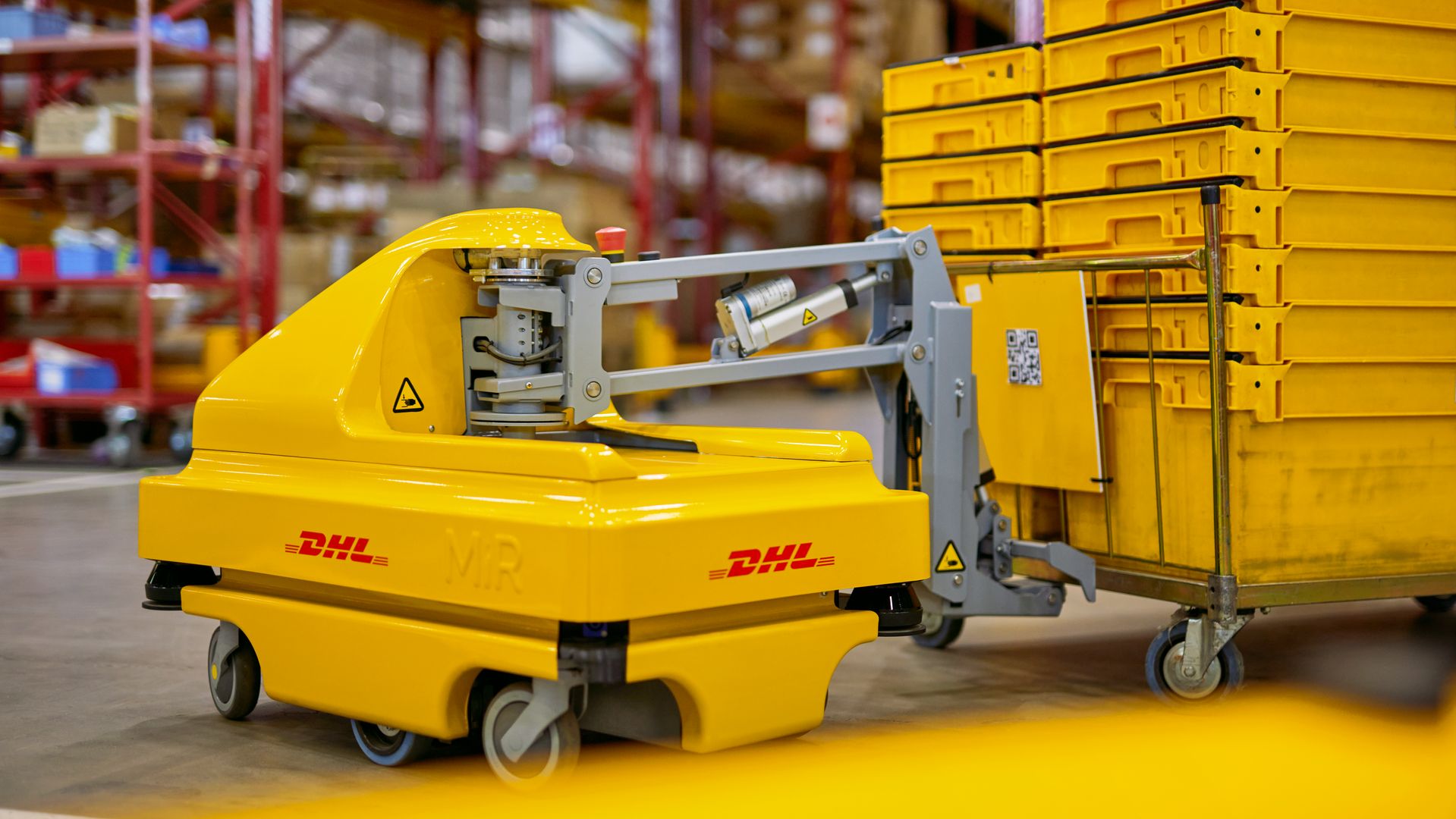
Squeezing through construction sites on European freeways is stressful. They often cause congestion and accidents. Driver assistance systems and smart driving help to handle them safely.
Congestion on construction sites: haulers caught between a rock and a hard place
When both traffic and patience are faltering: For professional truckers a high volume of transit usually means their stress levels are not far behind. When the schedule collapses, they are often the first to bear the clients’ grief. And that’s not to mention keeping to their personal driving and resting times, and the additional costs for the transport company involved.
The resulting damage to the economy runs to some 15 billion euros per year.“ Traffic expert Professor Michael Schreckenberg from the University of Duisburg-Essen reckons that 20 per cent of traffic jams in Germany are caused by construction sites.
Source: transportbotschafter.de
While the daily commute to the workplace or dense city traffic already spell a breaking test for many people’s nerves, the stress for those who not only simply ferry the daily bread as it were from A to B, but also earn their own daily bread from it, may have a serious impact on their health. This endangers not only their own safety, but also that of the other road users.
What’s more, the consequences of the climate crisis have made the situation for truck drivers even more difficult.

Construction sites: when entire infrastructures are lost to natural disasters
The flooding disaster in the Netherlands, Belgium and Luxembourg, as well as in the western and southern regions of Germany has left an immense degree of destruction in its wake. In many European regions the situation on the roads is visibly worsening due to environmental factors. As reported by the ADAC, in the Rhineland alone 90 kilometers of freeway are damaged. Entire transit infrastructures, including the A1, are in part no longer passable. Numerous bridges, national, regional and minor roads have been destroyed and need to be rebuilt. This leads to bottlenecks on alternative routes. The consequence: Roads hit their capacity limits, and professional drivers reach their mental limits. What is the best way to prepare for long-haul drives? And what can those concerned do themselves to stop stress levels from hitting the roof in the first place?
In order to respond to these and other questions we have put together eight valuable tips for dealing with particularly challenging situations in road traffic. They help to keep frustration and stress levels as low as possible, even if the queue around the construction site is once again getting longer and longer.
Congestion on the freeway: 8 ways for professional truckers to handle construction sites & Cie.
1. Keep exercise on board: Of course you’d like to – and need to – reach your destination as quickly as possible. Which is why it’s particularly important to take breaks from driving now and then and to allow the body regular short breaks from remaining in one and the same position. Stretching your legs for a bit walking around the truck, taking a few deep breaths, a small snack, a quick trip to the restroom, and it’s up and away onto the freeway.
Oftentimes, stopping is simply not an option in your schedule? Our tip: Use opportune moments, for instance when stopping at a traffic light, to stretch your legs and back, and shift your weight to reduce strain on individual parts of the body. While doing this, inhale slowly through the nose, exhaling through the mouth.
2. Stay calm when others overreact: When traffic lanes narrow, car drivers can become quite hectic. Which is why you should be prepared for them to swerve all of a sudden between lanes.
3. Look out for alternative routes: Use tools such as Google Maps or other route planners, to switch to an alternative route if necessary. These tools are continually analyzing transit conditions and will even automatically suggest different routes where they make sense. This increases the probability of efficient and smooth transit and doesn’t just save time but also spares your nerves.
4. Factor in time expenditure: Often construction sites operate a no-passing zone for trucks. This means the slowest road user will be setting the pace. Factor in more time for that part of your route.
5. Use the zipper-merge system: that way, construction sites with two lanes running in the same direction leave sufficient room for all vehicles, without leading to critical situations. Bear in mind that the collision of two vehicles driving alongside each other is the second-major cause of accidents on construction sites.
6. Feed your ears: Feed your ears and brain while you’re caught in a traffic jam by listening to a podcast for example. This keeps stress levels low. If you prefer things even calmer, relaxation music might be just the ticket for you.
7. Diet (also) helps: Healthy balanced nutrition is another contributing factor for better stress management.
And last but not least:
8. Using trip planning to avoid construction sites: Planning is everything – and professionals are aware of this more than anyone. Those wanting to avoid routes with construction sites can do exactly this using intelligent systems. Route planners such as Google Maps or ADAC Maps help to identify the location of construction sites and will suggest alternative routes. Information on known long-term construction sites, for instance in Germany, may be obtained from Construction Site Check and the Federal Road Research Institute’s Mobility Data Marketplace, based on the available data on construction sites provided by the German federal states.
More efficient travel with Greenplan
Financed by DHL, the Greenplan start-up offers a powerful algorithm for route optimization. Amongst other things, the system takes into account real time traffic flow, depending on the time of day. This allows very realistic and reliable tour planning. Compared to standardized solutions, Greenplan uses the Customer’s individual time and cost drivers as their starting point. The goal is massive increases in efficiency – up to 30 per cent. By the way, this algorithm was developed by scientists from the University of Bonn and DHL logistics experts.
The Bonn-based software company develops and distributes a SaaS solution for smart tour planning in the B2B sector. Greenplan´s dynamic and efficient planning approach enables optimized (last mile) delivery as well as field service management. Without the limitations of a strict, district-based logic per driver or per tour, Greenplan’s holistic approach to route planning optimization guarantees smarter distribution of volumes and improved use of existing vehicle capacities. Greenplan received the PostEurop Innovation Award 2020 and has been recognized as a WSIS Prizes Champion Project 2021.

Construction sites make life difficult for haulage companies, too
Truck drivers themselves can contribute a fair amount to making stressful situations on constructions sites more bearable. However, on a broader scale, which conditions need to improve? Karlhubert Dischinger, president of the Transport and Logistics in Baden-Württemberg association, demands: „We should stop having any exclusively day-time construction sites.“ At night, he explains, there is less traffic anyway, resulting in fewer traffic jams. This again would be of benefit to the environment, Dischinger adds. According to an ADAC survey 87 per cent of the around 2,000 drivers surveyed would like to see construction times on freeways reduced through weekend and night work. The majority found construction site management to be lacking (source: eurotransport.de).
A particularly critical hazard for truckers on construction sites are traffic switch zones, where entire lanes are switched to the oncoming lane. Often, bumpy ground will make truckers end up on the lane running parallel or onto divisional islands. Those are curbs usually filled with sand or water. Traffic islands and central barriers serve as lane dividers, too. While it depends on their stability they will not avoid a crash though!
Construction sites favor congestion – and congestion increases the likelihood of accidents. The number of rear-end collisions involving trucks and serious injury is increasing, as reported by the Association of Transport Professionals (BG). Here, the deployment of driver assist systems may be a decisive factor in the life of drivers and other road users.
Using driver assistance systems smartly
Accidents involving trucks are often particularly serious. Driver assistance systems, the Emergency Brake Assist, the Adaptive Cruise Control System (ACC) or the lane keeping/changing assistant for example, increase safety and efficiency at the same time. Here’s an overview:
- Emergency Brake Assist
Since 2015, newly licensed trucks with a total mass of over eight tons have had to be equipped with an emergency brake assist system. Three quarters of the trucks weighing above eight tons already feature this driver assistance system. Since 2018 the Advanced Emergency Braking System (AEBS) has also been obligatory for new utility vehicles weighing over 3.5 tons. The AEBS warns of obstacles ahead and starts the braking process if the driver doesn’t engage in it. Experts are calling for AEBS technology to be be developed further. The challenges here are to improve the interaction between the AEBS and the driver, to avoid oversteering.
- Adaptive Cruise Control System (ACC)
ACC sensors record the distance to the vehicle ahead and will automatically brake if that distance becomes too short. The main intention here is to avoid rear-end collisions during the stop & go on the construction site. In addition, the ACC system features cruise-control and is able to recognize stationary vehicles, cyclists and even pedestrians. - Lane keeping & lane changing assistant
In order to avoid that drivers involuntarily veer out of their lane, due to nodding off at the wheel for instance, a lane keeping and lane changing assist system is the optimal companion on the daily job on the road. The assistant does not only emit a clear acoustic warning signal when a driver leaves their lane. In addition, sophisticated systems will carry out an automatic steering correction. If during a lane change the distance to other vehicles becomes too short, the lane change assistant will sound and help effect the desired lane change without risking an accident.

The congestion hotspots
According to the ADAC congestion statistics for Germany, in terms of traffic jams one federal state has occupied the top position for years: In 2020, NorthRhine-Westphalia registered a third of all congestion alerts. And this was the case even though due to COVID-19 Germany registered 36 per cent fewer congestion alerts across the country.
The following freeways recorded particularly heavy traffic:
- The most congested stretch of freeway was the A 40 between Duisburg and Essen, clocking up a total of 10,610 alerts.
- With traffic jams lasting just over 4 hours on average, the A 46 between Düsseldorf and Wuppertal required the most patience from drivers.
- With a total of 10,589 kilometers, the longest traffic jams were recorded on the A1 between Cologne and Dortmund.
Numerous construction sites on main European transit routes
Many European transit routes present the danger of congestion because of major construction sites. Austria, Switzerland, and the Czech Republic for instance are hotspots for construction sites. Watch out for transit rerouting on the
- A2 Graz – Klagenfurt between Völkermarkt-West and Grafenstein in both directions (up to late November 2021 at least)
- A4 Vienna – Budapest between the Fischamend freeway rest stop and Bruck an der Leitha East in both directions (up to late October 2021 at least)
- A2 Chiasso – Gotthard between Faido and Airolo in both directions (up to late April 2022 at least)
- A8 Interlaken – Brienz between Iseltwald and Brienz in both directions (up to late December 2021 at least)
- A3 Zurich – Chur between Murg and Flums (up to October 2021 at least)
- D1 between Prague and Brno (up to the fall of 2021)
Why does construction work take so long?
Freeway construction sites are not only usually several kilometers long, their construction time also tends to stretch out a fair bit. There may be various reasons why construction sites will usually take years up to completion.
The reasons behind extended construction times:
Different companies
- Construction contracts are usually divided up into several sections, called lots. As there are usually different subsections involved – road highway construction, underground engineering and earth work – different companies are awarded the jobs. In most cases, these cannot work on one particular stretch at the same time, as particular tasks have to be completed before the next subsection can make a start. If this is the case, construction time invariably increases.
Weather
- Construction work is weather-dependent. To lay down certain types of coating for instance the ground has to be completely dry.
Night work
- Construction workers will deliberately schedule some tasks at night because the construction vehicles are able to work with fewer disturbances. However, not all suppliers have a permit for night driving. Furthermore, night work is more expensive due to insurance premiums, as well as more dangerous: Every corner of the construction site has to be illuminated.
Intermodal solutions by DHL Freight: an alternative to congestion
In order to reduce traffic jams, the ADAC recommends:
- upgrading chronically overstretched routes
- shifting cargo onto the railroad network
The new federal Autobahn GmbH corporation, responsible for all freeway projects since January 2021, is slated to get a few things rolling.
For a good while now, DHL Freight has been focussing on a combination of road and rail. On long-haul routes in particular, this kind of intermodal haulage pays off both in terms of the environment and the economy. Combining the environmental advantages of cargo trains with the flexibility of trucks, we will put together the optimal solution for your shipments. This is why over a quarter of a million trips in Europe are already multimodal. This means saying goodbye to traffic jams – as well as fewer emissions.
Arrive safely!



